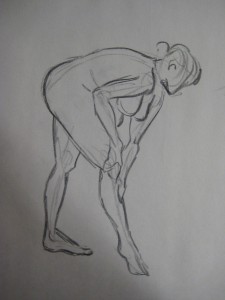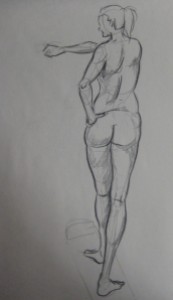Warning–this post contains pencil sketches of nude figures for education purposes.
After five sessions, my Illustration class has concluded its unit on drawing directly from the figure. Prior to drawing from a model, we learned from a model skeleton about the correct proportions of the human body. We were given bony points to look for in a live model such as the knees, elbows, top of the hips, and the shoulders, to help us mark correctly proportioned limbs. Below are examples of my figure drawing work, along with a little about the drawing process.
 The majority of our sessions were divided into 20 minute segments where we would draw 5 two-minute poses. Essentially, I would use the first 30 seconds of the pose to lightly mark the location of the head and the head, the joints, and the spine, connecting them all together with sketchy lines that suggest the figure, and then use the remaining minute and 30 seconds to draw in the contours of the body. Obviously there was no time to be super exact with any of my lines or measurements. Hands were bent rectangles, and the face if there was any suggestion of a face, would be a box or circle with a line marking the nose. Often times I was not even able to delineate the full gesture, and some of my figures go without feet or hands. This is not a problem though, as all of the drawings are meant to stay rough and are done for the practice.
The majority of our sessions were divided into 20 minute segments where we would draw 5 two-minute poses. Essentially, I would use the first 30 seconds of the pose to lightly mark the location of the head and the head, the joints, and the spine, connecting them all together with sketchy lines that suggest the figure, and then use the remaining minute and 30 seconds to draw in the contours of the body. Obviously there was no time to be super exact with any of my lines or measurements. Hands were bent rectangles, and the face if there was any suggestion of a face, would be a box or circle with a line marking the nose. Often times I was not even able to delineate the full gesture, and some of my figures go without feet or hands. This is not a problem though, as all of the drawings are meant to stay rough and are done for the practice.
 We did very few long drawings, 5 minutes at most near the end of class. Some of our drawings were even shorter than 2 minutes, done in 60 seconds. There was also an exorcise where we were asked to look at the model in a pose for 10 seconds. And then, from memory, draw that pose in 2 minutes. It was crucial to look at the angle of the shoulders and hips, and especially the angle and distance between the ankles. The most extreme test of our memories and our understanding of human proportions was the described poses. After drawing a model all day, and familiarizing ourselves with her (in this case) particular proportions, the model would leave the room, and our professor described a pose to us. We were than asked to draw our current model in that pose. It was surprisingly not that difficult, and I found that I drew much faster from my memory than I did constantly checking the model to make sure my curves were correct. That exorcise was definitely my favorite.
We did very few long drawings, 5 minutes at most near the end of class. Some of our drawings were even shorter than 2 minutes, done in 60 seconds. There was also an exorcise where we were asked to look at the model in a pose for 10 seconds. And then, from memory, draw that pose in 2 minutes. It was crucial to look at the angle of the shoulders and hips, and especially the angle and distance between the ankles. The most extreme test of our memories and our understanding of human proportions was the described poses. After drawing a model all day, and familiarizing ourselves with her (in this case) particular proportions, the model would leave the room, and our professor described a pose to us. We were than asked to draw our current model in that pose. It was surprisingly not that difficult, and I found that I drew much faster from my memory than I did constantly checking the model to make sure my curves were correct. That exorcise was definitely my favorite.
Early on in the unit, I was having trouble connecting my forms to one another, and I was drawing pieces of the models next to each other, and not really drawing them as all jointed together. My outlines were disconnected. And as always, no matter how many times the professor pointed it out to me and no matter how hard I was trying to see what he meant and thought I saw what he meant, it didn’t click until I figured it out for myself. And then all of a sudden, as with many things in art, a lightbulb goes on and I realize, “oh that’s what you meant! This is what it should look like.” Even seeing the more correct way drawn in front of me I couldn’t replicate it until this clicked! My second obstacle was realizing that it was easier if I drew lightly the whole 2 minutes. Again, the professor had said, draw lightly. And I did for the first 30 seconds when I mapping out the figure, but then I would begin to fill in my more detailed contours using a dark, heavy line. And then I would run into trouble finishing because this heavy line would slow me down. I would still draw very accurate figures, and figures that I liked, but I would be rushing. During the last week of the unit, it came to me that I should draw even the details lightly over my map. That way, I would not have to go over areas of my initial drawing that I wanted to keep to make them darker. I could just leave them because I drew them correctly the first time. And now I didn’t have to waist time drawing them again in the same exact way. This made it easier for me to finish more of the figure in the allotted time.
They say you can never do too much figure drawing, and that may be true, but I am satisfied with the amount of figure drawing I’ve done in the past two weeks and am ready for a break. Next year I will be taking a class where will be doing nothing but drawing from the figure, not just a unit on it. Hopefully there will be enough variety in the exorcises next year that I won’t get too tired of it. It’s the repetition of figure drawing that is tiresome for me. drawing 60 pictures of the same person, going through the same process, and making them just about the same size each time can get boring.
 One thing that I never get tired of in figure drawing is the immediacy of it. Two minutes and you move on, your piece is done, like it or not, and there is another chance to make a new and better pose, always. The end result comes so quickly which is very enjoyable for an impatient artist like me. I need things to be finished quickly; I don’t like to mess around building things up slowly. I’m all for experimentation, but when I’m not experimenting, I generally know what I want and want to put it there now.
One thing that I never get tired of in figure drawing is the immediacy of it. Two minutes and you move on, your piece is done, like it or not, and there is another chance to make a new and better pose, always. The end result comes so quickly which is very enjoyable for an impatient artist like me. I need things to be finished quickly; I don’t like to mess around building things up slowly. I’m all for experimentation, but when I’m not experimenting, I generally know what I want and want to put it there now.
It may sound paradoxical that I enjoy the immediacy but dislike the repetition. I know that the quicker I finish a drawing, the faster I move onto another one–encouraging the repetition. But it’s the only way I can describe it.
